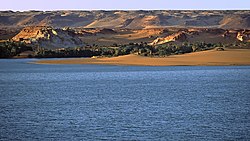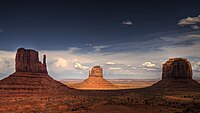Geography of Cashar
Cashar is typically divided into six loosely defined topographic zones: the Cashari Desert, the Ramort Plains, the Marjan and Walstret Mountains, the Sinka Oasis, the Pesodyna Mesas, and the Monran Coast. The largest of these areas are the Cashari Desert. The terrain in the Cashari Desert is quite flat and subject to areas of quicksand and brackish salt flats. The Ramort Plains are cut by the Auros River. Lake Sinka occupies much of the Sinka Oasis, making the areas around it quite rich in fertile soil suitable for agricultural development and pursuits. The next topographical area covers the Marjan and Walstret mountain ranges stretching from the west and from the east respectively. The highest peak belongs to Mount Lazez in the Marjan Mountains at 3,488 m. Northwest of the Marjan Mountain range is the Pesodyna Mesas, an area of rocky hills and flat-top plateaus. Finally, there's the coastline which extends to about 3000 kilometers.
The beaches are well-maintained, white sandy shores with beautiful crystal-clear waters. Cashar takes a lot of pride in its pristine environment. Tourism and animal trade is such a big industry in Cashar that economic interests lie heavily in ensuring the environment remains clean. The highest point is at an elevation of 3,488 m, and the lowest point is at sea level. It typically faces temperature extremes and has two distinct seasons. The winter months bring comfortable daytime temperatures while summer months are dominated by the heat. Annually, Cashar receives anywhere from 76 to 500 mm of rainfall per year.
Topographic Zones
Cashari Desert
The Cashari Desert is by far the largest area occupying Cashar. It can be found in every state; though, it is excluded from areas such as the Marjan Mountains, Walstret Mountains, and the smaller Ramort Plains. It can be considered partly a subtropical desert and partly an arid rain-shadow desert due to the location of the Marjan and Walstret mountain ranges. Sand dunes and sand seas make up only a minor part of the desert as it is mostly characterized by salt flats, dry fields, and dry lakes. The Cashari Desert also consists of scattered shrubland which can generally be found around the coastal areas, the Auros River, and the Sinka Oasis; though, occasionally due to small amounts of rainfall, it can be found elsewhere. The Cashari Desert is a modernized, international name for the desert. Locally, it is referred to as the Ramaras Desert. Ramaras is a Ketek word that can be broken into two parts: "ram" which is the word for "sand" and "aras" which is the word for "many spirits."
Sinka Oasis
The Sinka Oasis is a unique geographical feature and part of the Cashari Desert proper. It is located in the state of Danir. The oasis is centered around Lake Sinka, a freshwater lake which is about twenty-two square kilometers wide and 1,108 feet deep. The lake is thought to have formed as the result of an impact crater millions of years ago. The lake is largely fed by a natural underground aquifer. The Sinka Oasis gets its name from the Ketek word "sinka." It can be split into two parts: "sin" meaning "chest" and "ka" meaning "love." Roughly translated, it means "love chest" or "love in chest." It is generally meant to refer to a feeling of euphoria.
Ramort Plains
The Ramort Plains are a flat expanse of somewhat fertile land with very few trees. They are located primarily in the states of Shakel and Nykel. The plains are cut by the Auros River, which is largely responsible for the reason the plains exist in the first place. The word "ramort" is a Ketek word which can be split into two parts: "ram" meaning "sand" and "ort" meaning "finished" or "end." Roughly translated, it means "sand end." This is referring to the fact that the Ramort Plains is one of very few places in Cashar that is not desert.
Auros River
The Auros River is a singular river which exists in Cashar and stretches to 1,125 kilometers. It cuts through the Ramort Plains which are itself nourished by the river and through the states of Sostynak, Shakel, and Nykel, and ending in Krona. It is home to nearly 50 species of fish with about 20% being endemic. The Cashari people draw about 2 million cubic meters of water from this river each year as it is a major source of fresh water. The river gets its name from the Amiran word for "spirit" likely referencing the beliefs of Tabrodists especially given the Tree of Stones nearby.
Marjan Mountains
The Marjan Mountains are a mountain range which exist in southwestern Cashar. The range is mostly located in the state of Bitkan, but some of it stretches to the bottom tip of the state of Qindrak. The highest peak of the mountain is Mount Lazez which stands at 3,488 m. The mountain range gets its name from the Ketek word "marjan" which can be broken into two parts: "mar" meaning "stop" and "jan" meaning "wonder." It is generally taken to mean "wonder stop" referring to a place that is awe-inspiring. Mount Lazez gets its name from the Ketek word "lazez" which can be broken into two parts: "laz" meaning "birth" and "ez" meaning "from." It is generally taken to mean "from birth" which may refer to a Tabroda belief about the world and the Spirit of Stone.
Walstret Mountains
The Walstret Mountains are a mountain range which exist in northeastern Cashar. The range is located in the eastern portion of Shakel and Nykel and the southern portions of Krona and Drakam. The mountains are smaller, elevation-wise, compared to the Marjan Mountain range. The Walstret Mountains are home to an extensive network of caverns - one of which is the famous Alkmirt Caverns, known for its cave paintings from early humans in Alharu. The mountains get their name from the Ketek word "walstret" which can be broken into two parts: "wal" meaning "tall" and stret meaning "proud." It is often taken to mean "proudly tall."
Pesodyna Mesas
The Pesodyna Mesas are a unique geographical feature and part of the Cashari Desert proper. This area is known for its isolated, tabletop hills of varying sizes with the smallest coming in at .5 km and the largest coming in at 330 km. They lie primarily in the region of northwestern Bitkan and southern Qindrak. The Pesodyna Mesas get their name from the nearby city of Pesodyna, but in ancient times, they were also referred to as tabroda on proto-Madronian tablets.
Monran Coast
The Monran Coast is the coastline of Cashar which stretches to about 3,000 km. It is home to over 400 separate beaches which are kept pristine for tourists. The coastline is also where a majority of cities and towns congregate in Cashar due to much of the rest of Cashar being desert. It is not only an important part of the tourism economy in Cashar but also a valuable part of the ecosystem as it is home to several kinds of wildlife. One beach, in particular, is known as Javelina Beach for the rampant number of wild desert pigs who wander the beach and swim in the waters. The Monran Coast gets its name from the Monran Bight, which itself has origins in Ketek. The word "monran" can be split into two distinct parts "mon" meaning "wet" and "ran" meaning "slow." Roughly translated, it means "slow wet." It refers to the slow and rhythmic way in which water laps at the shore.



